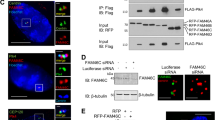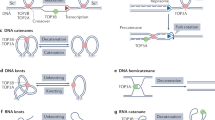Abstract
Topors was identified recently as a human protein that binds to topoisomerase I and p53. Topors contains a highly conserved RING domain and localizes in promyelocytic leukemia nuclear bodies. Relatively little is known regarding topors expression patterns or function. We now demonstrate that topors mRNA and protein are widely expressed in normal human tissues. By contrast, topors mRNA and protein levels are decreased or undetectable in colon adenocarcinomas relative to normal colon tissue, and expression of the topors protein is not detectable in several colon cancer cell lines. The human TOPORS gene is located on chromosome 9p21, with loss of heterozygosity in this region frequently observed in several different malignancies. While we were unable to detect loss of heterozygosity of the TOPORS gene in 16 sporadic colon cancer cases, increased methylation of a CpG island in the TOPORS promoter was evident in colon adenocarcinoma specimens relative to matched normal tissues. Additional studies indicate that forced expression of topors inhibits cellular proliferation and is associated with an accumulation of cells in the G0/G1 phase of the cell cycle. This effect is independent of the topors RING domain and maps to a C-terminal region of the protein. These results suggest that topors functions as a negative regulator of cell growth, and possibly as a tumor suppressor.
This is a preview of subscription content, access via your institution
Access options
Subscribe to this journal
Receive 50 print issues and online access
$259.00 per year
only $5.18 per issue
Buy this article
- Purchase on Springer Link
- Instant access to full article PDF
Prices may be subject to local taxes which are calculated during checkout






Similar content being viewed by others
References
Boutell C and Everett RD . (2003). J. Biol. Chem., 278, 36596–36602.
Boutell C, Sadis S and Everett RD . (2002). J. Virol., 76, 841–850.
Chang J, Dethlefsen LA, Barley LR, Zhou B and Cheng Y . (1992). Biochem. Pharm., 43, 2443–2452.
Chu D, Kakazu N, Gorrin-Rivas MJ, Lu HP, Kawata M, Abe T, Ueda K and Adachi Y . (2001). J. Biol. Chem., 276, 14004–14013.
Cui X, Feiner H, Lin Z and Li H . (2000). J. Mol. Diagn., 2, 29–36.
Devlin J, Elder PA, Gabra H, Steel CM and Knowles MA . (1996). Br. J. Cancer, 73, 420–423.
Dyck JA, Maul GG, Miller Jr WH, Chen JD, Kakizuka A and Evans RM . (1994). Cell, 76, 333–343.
Frommer M, McDonald LE, Millar DS, Collis CM, Watt F, Grigg GW, Molloy PL and Paul CL . (1992). Proc. Nat. Acad. Sci. USA, 89, 1827–1831.
Giovanella BP, Stehlin JS, Wall ME, Wani MC, Nicholas AW, Liu LF, Silber R and Potmesil M . (1989). Science, 246, 1046–1048.
Haluska PH, Saleem A, Rasheed Z, Ahmed F, Su EW, Liu LF and Rubin EH . (1999). Nucleic Acids Res., 27, 2538–2544.
He D, Nan X, Chang KS, Wang Y and Chung LW . (2003). Chin. Med. J. (Engl.), 116, 1394–1398.
Herman JG, Merlo A, Mao L, Lapidus RG, Issa JP, Davidson NE, Sidransky D and Baylin SB . (1995). Cancer Res., 55, 4525–4530.
Joazeiro CA, Wing SS, Huang H, Leverson JD, Hunter T and Liu YC . (1999). Science, 286, 309–312.
Kamb A, Gruis NA, Weaver-Feldhaus J, Liu Q, Harshman K, Tavtigian SV, Stockert E, Day 3rd RS, Johnson BE and Skolnick MH . (1994). Science, 264, 436–440.
Kim SK, Ro JY, Kemp BL, Lee JS, Kwon TJ, Fong KM, Sekido Y, Minna JD, Hong WK and Mao L . (1997). Cancer Res, 57, 400–403.
Li H and Hood L . (1995). Genomics, 26, 199–206.
Li LC and Dahiya R . (2002). Bioinformatics, 18, 1427–1431.
Merlo A, Herman JG, Mao L, Lee DJ, Gabrielson E, Burger PC, Baylin SB and Sidransky D . (1995). Nat. Med., 1, 686–692.
Narla G, Heath KE, Reeves HL, Li D, Giono LE, Kimmelman AC, Glucksman MJ, Narla J, Eng FJ, Chan AM, Ferrari AC, Martignetti JA and Friedman SL . (2001). Science, 294, 2563–2566.
Nobori T, Miura K, Wu DJ, Lois A, Takabayashi K and Carson DA . (1994). Nature, 368, 753–756.
Nuovo GJ, Plaia TW, Belinsky SA, Baylin SB and Herman JG . (1999). Proc. Natl. Acad. Sci. USA, 96, 12754–12759.
Perinchery G, Bukurov N, Nakajima K, Chang J, Li LC and Dahiya R . (1999). Int. J. Cancer, 83, 610–614.
Pollock PM, Welch J and Hayward NK . (2001). Cancer Res., 61, 1154–1161.
Puig S, Ruiz A, Lazaro C, Castel T, Lynch M, Palou J, Vilalta A, Weissenbach J, Mascaro JM and Estivill X . (1995). Am. J. Hum. Genet., 57, 395–402.
Rasheed ZA, Saleem A, Ravee Y, Pandolfi PP and Rubin EH . (2002). Exp. Cell Res., 277, 152–160.
Schraml P, Struckmann K, Bednar R, Fu W, Gasser T, Wilber K, Kononen J, Sauter G, Mihatsch MJ and Moch H . (2001). Am. J. Pathol., 158, 593–601.
Waber P, Dlugosz S, Cheng QC, Truelson J and Nisen PD . (1997). Oncogene, 15, 1699–1704.
Weger S, Hammer E and Engstler M . (2003). Exp. Cell Res., 290, 13–27.
Wiest JS, Franklin WA, Otstot JT, Forbey K, Varella-Garcia M, Rao K, Drabkin H, Gemmill R, Ahrent S, Sidransky D, Saccomanno G, Fountain JW and Anderson MW . (1997). Cancer Res., 57, 1–6.
Zhou R, Wen H and Ao SZ . (1999). Gene, 235, 93–101.
Acknowledgements
This work was supported by Public Health Service Grants GM59170 and CA39662 from the National Cancer Institute. We thank Julie Friedman for assistance in obtaining human tissue specimens.
Author information
Authors and Affiliations
Corresponding author
Rights and permissions
About this article
Cite this article
Saleem, A., Dutta, J., Malegaonkar, D. et al. The topoisomerase I- and p53-binding protein topors is differentially expressed in normal and malignant human tissues and may function as a tumor suppressor. Oncogene 23, 5293–5300 (2004). https://doi.org/10.1038/sj.onc.1207700
Received:
Revised:
Accepted:
Published:
Issue Date:
DOI: https://doi.org/10.1038/sj.onc.1207700
Keywords
This article is cited by
-
p28, A first in class peptide inhibitor of cop1 binding to p53
British Journal of Cancer (2013)
-
Deficiency of the dual ubiquitin/SUMO ligase Topors results in genetic instability and an increased rate of malignancy in mice
BMC Molecular Biology (2010)
-
Plk1 phosphorylation of Topors is involved in its degradation
Molecular Biology Reports (2010)
-
The substrates of Plk1, beyond the functions in mitosis
Protein & Cell (2010)
-
topors, a p53 and topoisomerase I-binding RING finger protein, is a coactivator of p53 in growth suppression induced by DNA damage
Oncogene (2005)



